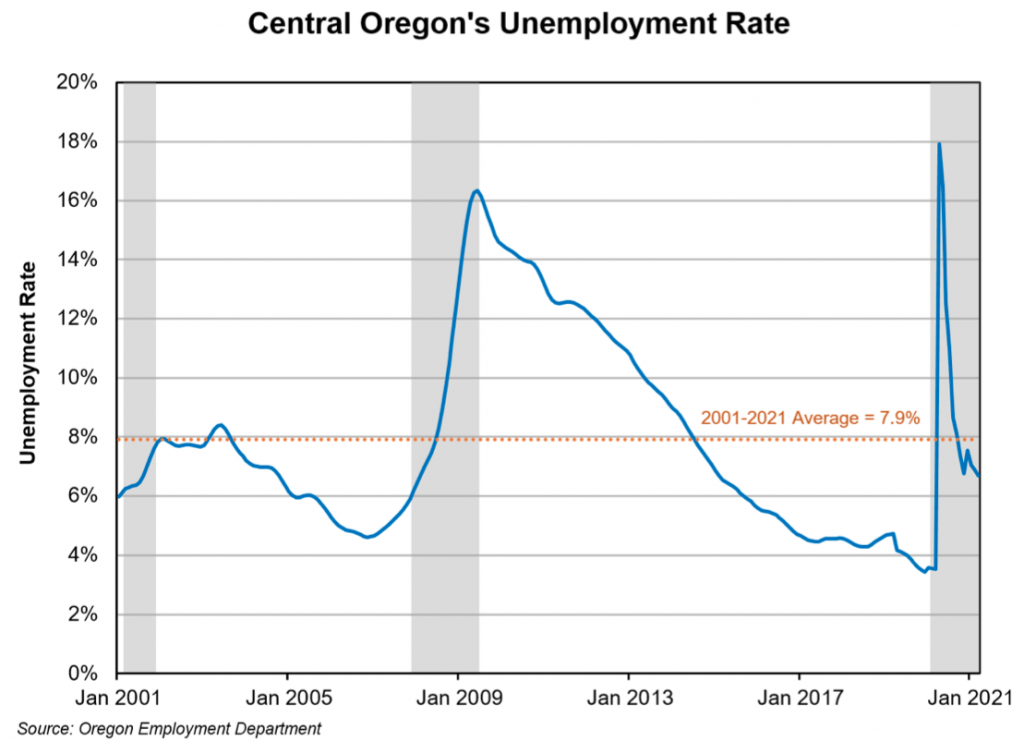Central Oregon’s Latest Unemployment Levels Lower than Long-Term Average
As local and statewide economic conditions continue to improve, Oregon’s employers are having a difficult time hiring labor in today’s economy when unemployment levels are markedly higher than they were leading up to the pandemic. Typically after an economic downturn, there’s a greater supply of labor to employ as job openings begin to materialize again. This isn’t necessarily the case today, as employers are experiencing difficulty in filling their job vacancies like they were pre-COVID. For a while, the state was posting unemployment rates south of 4.0%, reaching a record low of 3.3% in November 2019. Unemployment shot up to 13.2% in April 2020, as COVID restrictions took effect. Now, the statewide unemployment rate just edged down to 6.0% in March 2021, lower than the long-term average of 6.8%.

Here in Central Oregon, the same narrative plays out: Record low unemployment rates heading into the pandemic, a rapid spike in unemployment once COVID-19 hit, followed by a steady decline ever since. Still, Crook, Deschutes, and Jefferson counties have noticeably higher unemployment rates than they did leading up to spring of 2020 with 7.3%, 6.6%, and 6.8% unemployment rates in March, respectively. These are significant improvements from Crook and Deschutes counties’ pandemic high of 18.3%, and Jefferson County’s high of 17.0%. In fact, Central Oregon’s unemployment levels are well below their long-term average from 2001 to 2021.
Using a regional average, Central Oregon’s March 2021 unemployment rate of 6.7% is significantly lower than its average rate of 7.9% over that last two decades. While it took 69 months for the region to reach a 6.7% unemployment rate from the Great Recession peak, it has been only 12 months to get to this level since the peak of the COVID-19 Recession. That’s a significant swing in a short amount of time. A pivotal factor to consider when looking at this metric is that over half of the job losses in Oregon today are temporary. Those are folks who expect to be called back to their original place of work, and aren’t necessarily looking to fill another job opening.
Also, while all sectors shed jobs at the onset of COVID-19, many have seen a large number of those jobs (if not all) return over the last year. Depending on the type of job employers are hiring for, there might not be the excess labor pool to fill those positions that might be expected from elevated levels of unemployment. As it turns out, both Oregon and Central Oregon’s labor markets are tighter than you might think, and it’s not due to only one reason. Rather, it’s a combination of unprecedented factors that are hampering the potential supply of labor. This includes limited child care vacancies; working parents’ inability to work remotely; persisting concerns about exposure to the COVID-19 virus at work; and both enhanced unemployment insurance benefits and expanded eligibility. Since it is a combination of these factors for most of Oregon’s unemployed workers, it’s unlikely that the enhanced UI benefits, alone, are keeping a vast number of workers from jumping into these open job vacancies.
It’s important to keep in mind the continued dilemma of today’s situation for many Oregonians. There are still constraints on our personal, social, and professional lives that impact the ability for many individuals to participate in the workforce. Pair that with the fact that half of the job losses are temporary and unemployment rates are well below their long-term average, this all helps provide some context for why our labor market is tighter than expected.


Advertisement